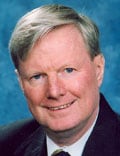A novel, once-nightly formulation of sodium oxybate is safe and effective for treating both subjective and objective symptoms of narcolepsy, new research suggests.
Top-line results from the phase 3 REST-ON trial released earlier this year showed that the agent known as FT218 (Avadel Pharmaceuticals) met all three of its co-primary efficacy endpoints at all three doses assessed (6 g, 7.5 g, and 9 g). Patients receiving the drug showed significantly greater improvements on the Maintenance of Wakefulness Test (MWT), the Clinical Global Impression of Improvement (CGI-I) and mean weekly attacks of cataplexy compared with those who received placebo.
The new analyses, which focused on key secondary outcomes, showed that all three doses of the novel agent were associated with significant improvements in sleep quality, refreshing nature of sleep, sleep paralysis, disturbed nocturnal sleep, and scores on the Epworth Sleepiness Scale (ESS).

Dr Michael Thorpy
Principal investigator Michael J. Thorpy, MD, director of the Sleep-Wake Disorders Center at the Montefiore Medical Center, New York City, said in a release that the results represent “the promise of a potential new treatment strategy for physicians and patients.”
“I am particularly impressed by the consistency of results as early as 3 weeks with only a 6 g dose,” he added.
Thorpy, who is also a professor of neurology at the Albert Einstein College of Medicine, noted that the new formulation will be more convenient for patients.
“The advantage of this medication is its once-nightly formulation, so patients don’t need to awaken during the night and can actually have a better night’s sleep,” he told Medscape Medical News.
Thorpy presented the study findings at the virtual American Academy of Neurology (AAN) 2021 Annual Meeting.
FT218 is currently under review by the US Food and Drug Administration (FDA), which has set October 15 as the Prescription Drug User Fee Act target date.
Forced Awakening
Sodium oxybate was first approved by the FDA in 2002 to treat cataplexy in adults with narcolepsy and, as reported by Medscape Medical News, was expanded in 2005 to also treat excessive daytime sleepiness (EDS). That formulation is indicated for twice-nightly administration, with the second dose taken 2.5 to 4 hours after the first.
“The need for forced awakening to take the second dose…may result in noncompliance, which may lead to reduced efficacy and/or mistimed doses,” the investigators note.
FT218 is a modified-release version of sodium oxybate. A single 6-g dose of the investigational agent “has shown bioequivalent exposure to twice-nightly immediate-release [sodium oxybate] given as two 3-g doses,” write the researchers.
It also currently has Orphan Drug Designation from the FDA for the treatment of narcolepsy.
The randomized, double-blind, placebo-controlled, multicenter REST-ON study was conducted from November 2016 to March 2020 and included patients 16 years or older who had narcolepsy type 1 or type 2.
Patients received the active treatment (n = 107; mean age, 30.9 years; 64.5% women) or placebo (n = 105; mean age, 31.6 years; 71.4% women) according to a 4-period forced uptitration dosing schedule of 4.5 g for 1 week, 6 g for 2 weeks, 7.5 g for 5 weeks, and 9 g for 5 weeks.
Secondary outcome measures included the ESS, sleep quality/refreshing nature of sleep on a visual analogue scale, sleep paralysis and hypnagogic hallucinations on a sleep symptoms diary, disturbed nocturnal sleep on polysomnographic measures, and number of arousals as defined per the American Academy of Sleep Medicine Score Manual.
Reports of adverse events (AEs) were collected from time of informed consent until 7 days after the last dose received.
Improvement Across Doses
Results showed that, compared with placebo, improvement in disturbed nocturnal sleep from baseline was significantly greater for the active treatment at 6 g at week 3 (mean between-group difference, -11; P < .001), at 7.5 g at week 8 (mean difference, -17.7; P < .001), and at 9 g at week 13 (mean difference, -22.6; P < .001).
The mean difference between the three doses and placebo for reduction in number of arousals was -11.3 (P < .05), -19.4 (P < .001), and -23.7 (P < .001), respectively. And the 6 g at Week 3, 7.5 g at Week 8, and 9 g at Week 13 doses showed significant (P < .001) improvements vs placebo on the ESS (mean difference, -2.1, -3.2, and -3.9, respectively).
All three doses also showed significant improvement in sleep quality and refreshing nature of sleep (P < .001 for all comparisons), as well as improvement of sleep paralysis (P = .04, P = .02, and P = .04, respectively).
There were no significant differences between FT218 and placebo for improvement in hypnagogic hallucinations.
Thorpy noted that the number of patients with baseline hallucinations “was relatively small,” which may have led to this finding.
“Had there been a much larger population with hallucinations, I suspect that we would have seen a statistically significant improvement there as well,” he said.
Generally Well Tolerated
The investigators note that FT218 was “generally well tolerated, and the most common adverse reactions were well-known and established sodium oxybate adverse reactions.”
Treatment-related AEs that occurred in more than 2% of the patients receiving FT218 included nausea, dizziness, enuresis, headache, decreased appetite, and vomiting.
Seven serious AEs were reported, including 5 in those assigned to the active treatment. This included one case each of diabetes inadequate control, paresthesia, perirectal abscess, hypertension, and suicidal ideation. Only the case of suicidal ideation was considered to be a treatment-related AE.
The investigators note that although they have not yet delved into subgroup analysis to look for differences among sex, age, or race, they plan to do so in the future.
Overall, the results indicate that “FT218 is an effective agent not only for the major symptoms of sleepiness and cataplexy, but also the quality of sleep at night,” said Thorpy.
Asked whether he thinks the FDA will approve the drug, he said that it should be “straightforward” because it’s just a different formulation of an already-approved agent.
“I very much expect there will not be any problems in this medication being approved,” Thorpy said.
Benefits “Sleep Architecture”

Dr Logan Schneider
Commenting on the findings for Medscape Medical News, Logan Schneider, MD, co-director of the Stanford/VA Alzheimer’s Center and clinical assistant professor (affiliated) at the Stanford Sleep Center, Redwood City, California, said that the investigators’ focus on these secondary outcomes “was really worthwhile.”
Schneider, who was not involved in the research, noted that because the study only included patients with narcolepsy, the results can’t be extrapolated to groups who have other sleep disorders.
Still, “it is worthwhile now to expand beyond the two primary symptoms that are, in my consideration, life threatening: daytime sleepiness and cataplexy. We should also address more of the quality of life and other aspects of narcolepsy, including disturbed nocturnal sleep and sleep quality issues related to that,” he said.
“Being able to address those aspects and say, ‘I have a therapy that clearly helps the multidimensionality of our patients’ is very vindicating,” Schneider noted.
He was also impressed with the various measures the researchers used, rather than relying just on patient reports, “which are subject to recollection difficulties. This was a nice way to quantify possibly as a diagnostic marker the underlying disruption of sleep, as well as a possible treatment marker to show how well a therapy works.”
“It actually shows a beneficial effect on sleep architecture,” Schneider said.
The study was funded by Avadel Pharmaceuticals. Thorpy is a consultant/advisory board member for Avadel, Axsome, Balance Therapeutics, Eisai, Harmony Biosciences, Jazz Pharmaceuticals, NLS Pharmaceuticals, Suven Life Sciences, and Takeda Pharmaceutical. Schneider reports being an advisor and/or on the speakers’ bureau for similar drugs by Jazz Pharmaceuticals and Harmony Biosciences.
American Academy of Neurology (AAN) 2021 Annual Meeting.
Presented April 17, 2021. Abstract
For more Medscape Neurology news, join us on Facebook and Twitter
Source: Read Full Article
